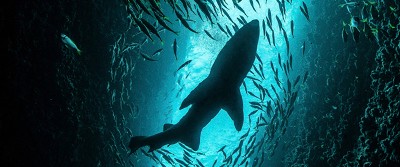Shark Embryos and the Search for Food

By Mike Howie
Because traditional ultrasound technology doesn’t function underwater, it’s difficult to study the inner workings of sharks without performing invasive surgery. But Japanese scientists were recently able to learn unexpected facts about shark pregnancy thanks to a new tool called underwater ultrasound.
Using the tool, divers regularly observed embryos inside the two uteruses of a captive tawny nurse shark. Over time, they noticed that the number of embryos in each of the shark’s two uteruses, which are connected in a U shape, would change. When the total number of embryos in one uterus decreased, the number in the other uterus increased by the same number.
Migrating in the Womb
The observation suggested that the embryos were moving between the two uteruses, which contradicted the idea that embryos mostly stayed in one place and couldn’t move much. In at least three other shark species, recent evidence has shown that embryos can only move their mouths. When the ultrasound showed an embryo actively moving from one uterus to the other, the scientists had the first conclusive evidence that tawny nurse shark embryos are more active than expected.
The scientists now suspect that all this movement helps the embryo find the food it needs to develop and survive. Tawny nurse sharks feed their unborn young through a process called oophagy, which literally means egg eating. Instead of receiving nutrients through a placenta and an umbilical cord, like mammals, these shark embryos eat their mother’s unfertilized eggs. But they have to move around to find these eggs, and sometimes that means they have to move between the two uteruses. According to the researchers’ data, published in the journal Ethnology, some embryos switched uteruses as few as three times and others switched as many as 24 times.
But that wasn’t all the researchers learned. Their underwater ultrasound also recorded that the mother’s cervix opened slightly during the pregnancy. When it did, the embryo exposed its head. This was also in contrast to mammalian pregnancies, during which the cervix is tightly closed until birth.
New Proof for an Old Question
This new data answers a question that scientists began asking in 1993, when Discovery Channel footage of invasive surgery on a sand tiger shark showed embryos moving from one uterus to the other. Because the footage was recorded under unnatural conditions, many wondered if the behavior would happen in the course of a normal pregnancy.
Tawny nurse sharks and sand tiger sharks have similar pregnancies — both feed their embryos through oophagy and give birth to live young instead of laying eggs. In addition to eating the mother’s unfertilized eggs, sand tiger shark embryos will even eat their developing siblings, ensuring that only the largest and strongest survive.
Thanks to the scientists in Japan, we now know a little bit more about the mysteries of shark pregnancy, and just how different it can be from mammalian reproduction.
Discussion Questions
- In what other ways are shark and mammalian reproduction different?
- What do you think are the benefits of having two uteruses?
Vocabulary
- Oophagy
- Embryo